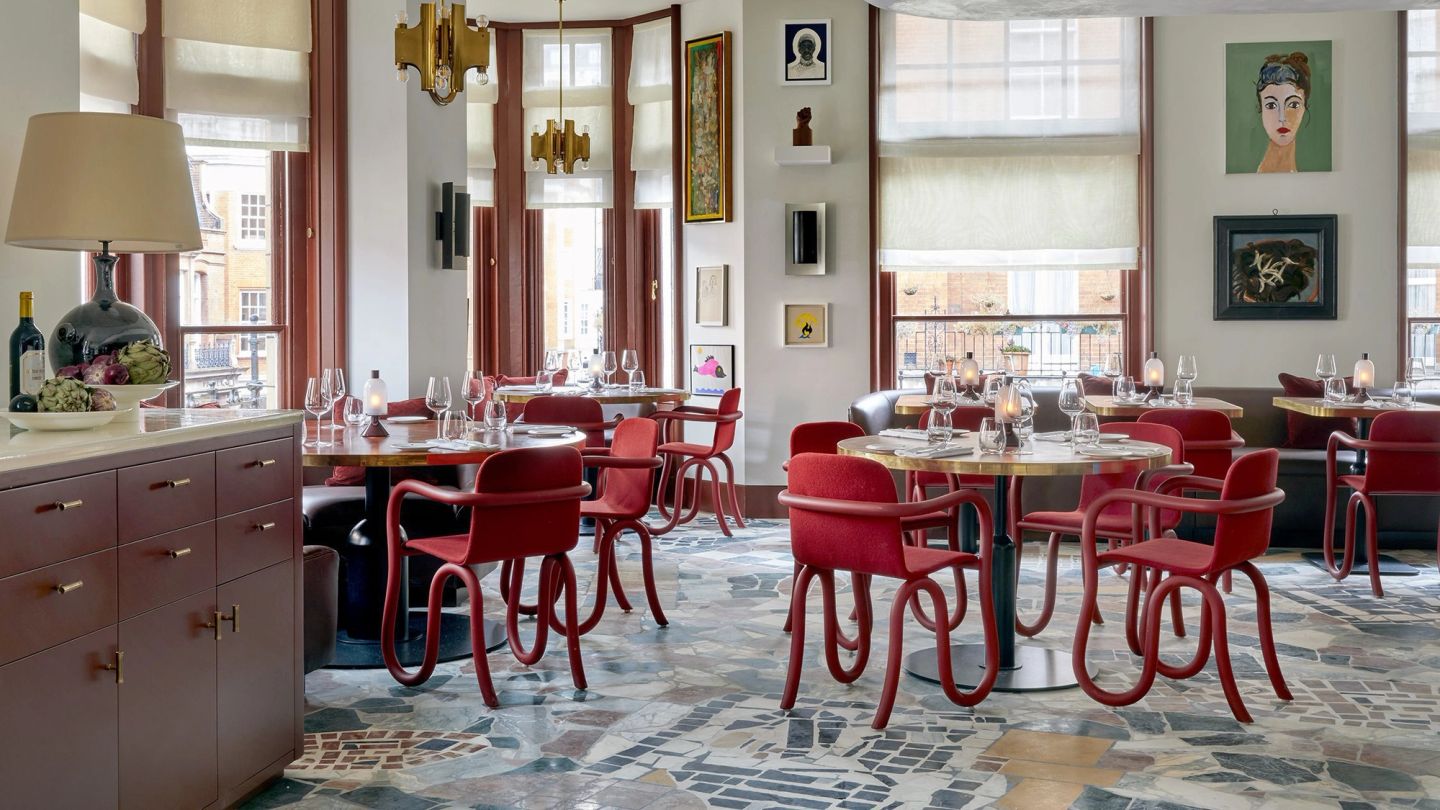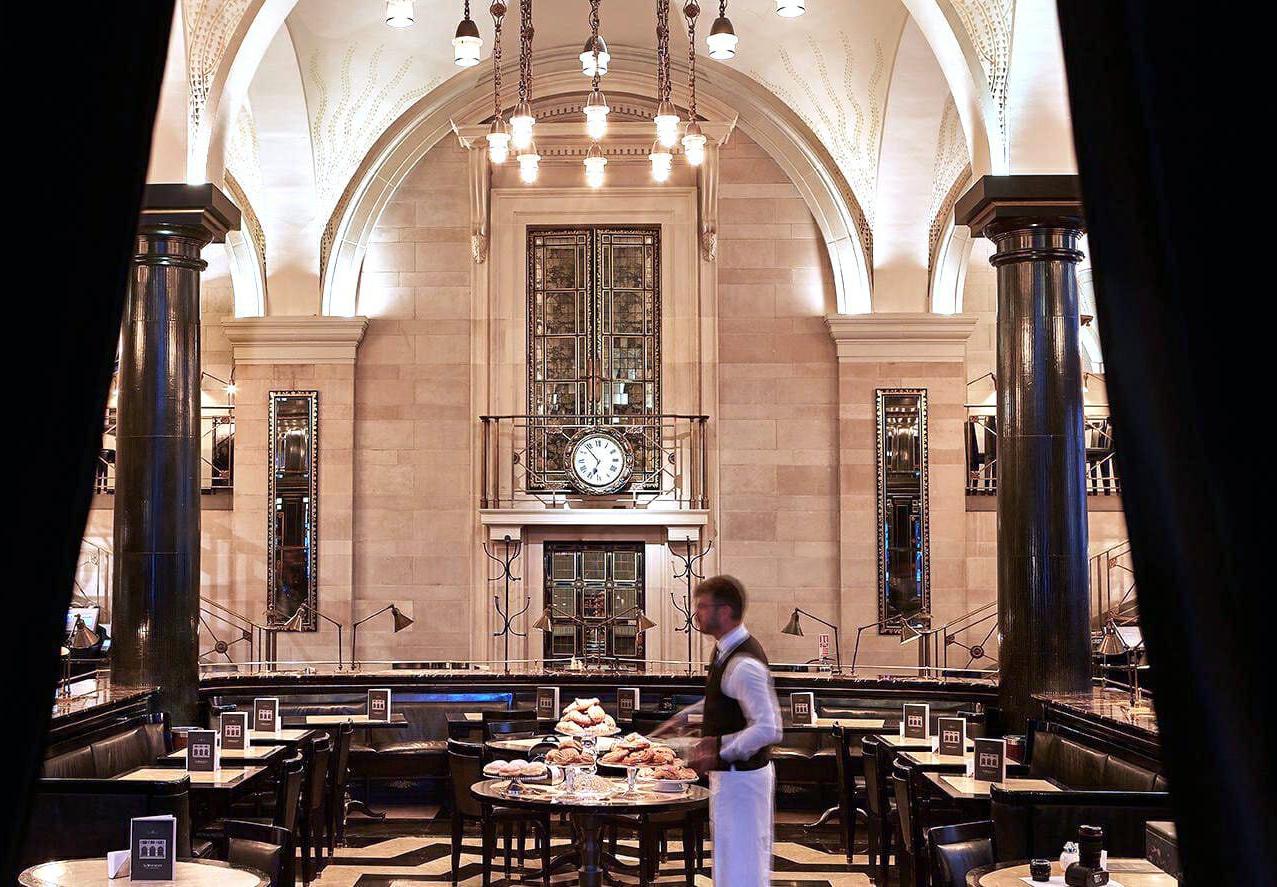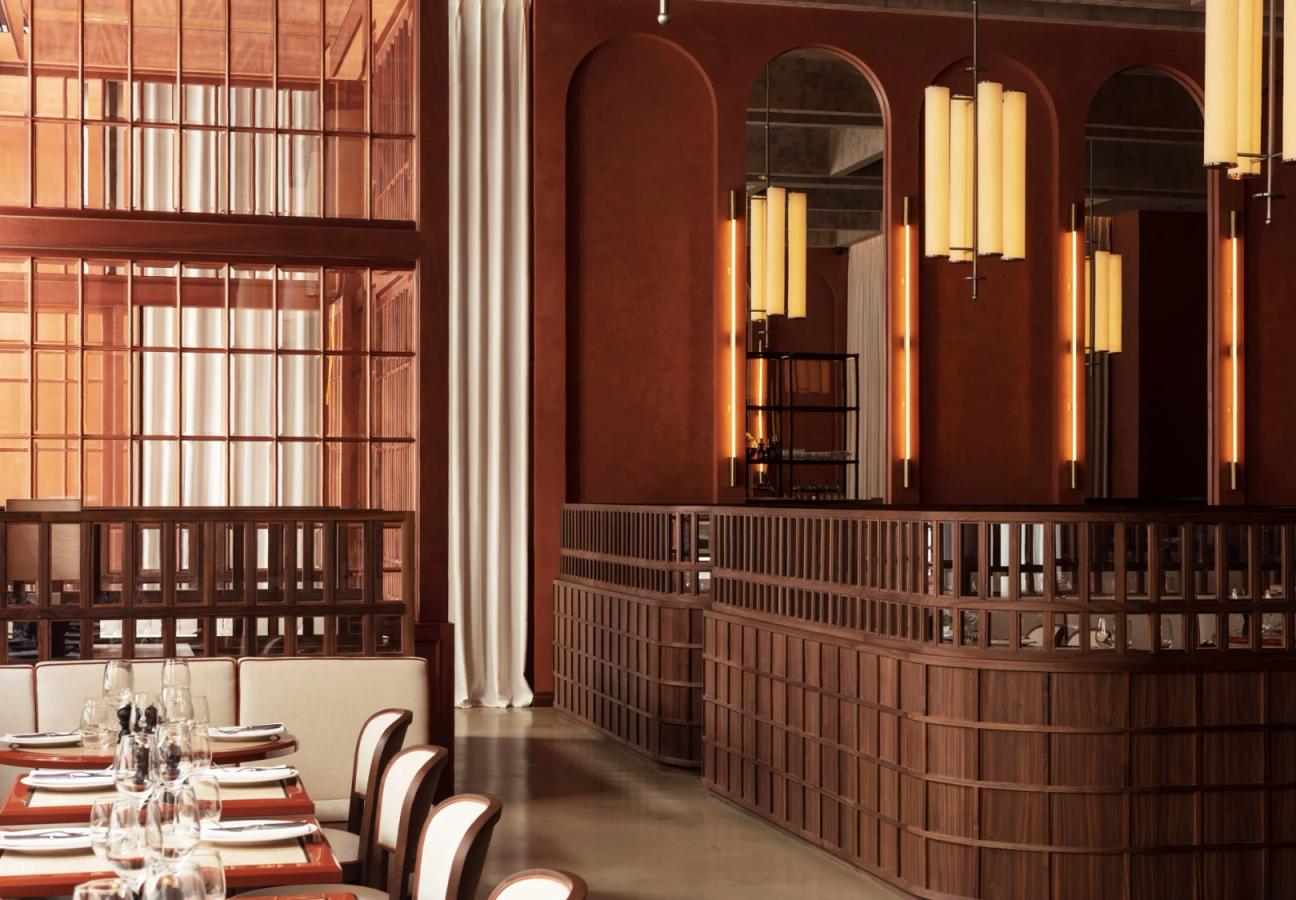

The power lunch is dead; long live the power lunch
Whatever happened to the art of the long lunch? Some of London's most clubbable businessmen weigh in.
Words: Joseph Bullmore
“I’m doing the antithesis of power lunching at this very moment,” said Ben Elliot one lunchtime recently. “I’m eating a sandwich at my desk.” Ten years ago, such an admission from the ultra-connected, utterly-lunchable Elliot (the Quintessentially co-founder, of course) would have read like a distress signal, a cry for help, a hissing red flare from the Mayfair hinterlands. A concerned pal might pop round with smelling salts and a prepared speech; maitre d’s across town would wonder whether they’d done something wrong. But in 2025, dining ‘al desko’ (a yucky formulation) is a perfectly valid lunchtime option for the common-or-garden master of the universe — along with Deliveroos to the sofa while WFH, or sloping into a suburban gastropub for a solo shepherd’s pie and a snooze.
The power lunch — that great institution where captains of industry, theatrical impresarios, political maestros and any number of scavenging hacks would sashay into a dining room four lunchtimes a week to meld business and pleasure under the watchful choreography of a master restaurateur — is not as it was. And depending on where you’re sitting, this is either part of the natural order of things — along with the decline of the bowler hat and the briefcase — or a sad hollowing out of our capital’s traditions; a sorry symptom of covid, recession, wellness fanaticism, Zoomification and general boringness.

The Wolseley.
Or perhaps it’s just that The Wolseley’s gone. Well, I say gone. The institution by that name still opens up its doors on Piccadilly at the same time every morning, and still serves its dressed crab and steak tartare to the guileless Americans who wander into its marbled depths because the Ritz is full. But the real Wolseley — the one crafted by Jeremy King and Chris Corbin into a theatre of power and poise — has departed, taken from this earthly realm when Minor International, Corbin & King’s financial overlords, nabbed the business from the restaurateurs through various skulldugeries in February 2022.
“That was where everyone had lunch,” says Giles Coren, the Times restaurant critic, “whether you were a Mayfair hedgy or a theatrical agent or you were Lucian Freud, you were in the Wolseley come lunchtime — and you can’t go there now because Jeremy’s gone,” he explains. “So where do they all go now? That puts them in a bit of a crisis…” The management has now swapped the paper towels in the bathroom for an electric hand dryer — a sign, surely, of the end times.
"One regular would have a guest at 12 o’clock and a guest at 2 o'clock and have lunch twice..."
The Wolseley was salt in the wound. But the rot had set in years before. Things peaked in the late 1990s, anecdotally, when London became a melting pot of new media companies (Fitzrovia, Soho) a lively celebrity class (the West End), Cool Britannia gadabouts (Notting Hill, The River Cafe) — plus the ever-established financiers and politicians (the City, Mayfair), and the auction house/fine-art bunch (St James’s) who back then had more liberal expense accounts and scarcely a dial-up connection, let alone a Google Meets addiction.
“I used to get so excited going to the Caprice for lunch,” remembers Elliot, citing the Corbin & King power restaurant of the 1990s and 2000s. “It was so eclectic. I loved going to a dining room filled with agents, people in the art world, captains of industry, politicians. I just don’t see that kind of room here at the moment.” David Moore, the owner of Michelin-starred Pied-a-Terre in Fitzrovia, told the Times last summer about a customer he used to call ‘Timmy Two Lunches’ during the 1990s. “He’d have a guest at 12 o’clock and a guest at 2 o’clock and have lunch twice. He said he did all his most important business over lunch.” After the pandemic, Pied-a-Terre was closed for lunch on all weekdays but Friday.
The old interiors of Le Caprice (now rightfully resurrected as Arlington).
“The long, boozy lunch used to happen everyday of the week,” says Will Woodhams, the recently departed CEO of high-end bookmakers Fitzdares. “Then they moved to Friday, and now that anyone who’s anyone works from home on a Friday, they’ve moved to Thursdays and possibly Tuesdays, for some reason,” he says. “But it’s not the same”. I ask Woodhams what the menu used to consist of back in the day, expecting him to reel off sashimi and black cod and chateaubriand. But the response is tellingly liquid. “It went martini, white burgundy, red claret — and then you’d go and stand outside the Guinea Grill [on Mayfair’s Bruton Place] for a few hours,” he laughs. “You had your big boozy lunch then went to stand outside the pub afterwards. Terrible!”
Seen from an era of ultra-optimization and Californian cleanliness, this all looks a little too Nigel Farage for many to stomach; a little pinstriped and gouty. In fact, a la Farage: globalisation may well have been the beginning of the end for the power lunch, explains Ed Cumming, food columnist at the Telegraph Magazine. “Back in the day, the pinstripes-and-deep-banquettes era, you’d have claret and steak and seal the deal and then get trashed all afternoon,” he says. “That’s totally outdated, obviously. The problem was that, once the City over here got massive, it welcomed all the Americans, who were anathema to power lunches because they didn’t like drinking during work.”
George, in Mayfair.
There’s also the question of necessity, or the lack of it. When everyone was in the office by default five days a week, you needed to find reasons to go outside once in a while, if only to break things up. (Cigarettes, also on the wane, served a similar purpose). “The reason for the power lunch used to be that you were in the office all day, but there wasn’t really 10 hours of work to do in a day,” says Coren. “So you’d go off and have a marvellous meeting over a long lunch and say it was work. Now, people I know with proper jobs get their work done in the morning and walk the dog on Hampstead Heath in the afternoon. They don’t need to go into the office and then spend the afternoon at Rules.”
“The real power lunches take place at off-the-beaten-track restaurants at off-peak hours..."
But for every movement there is a counter movement, of course. And, like wearing Hermes ties or knowing how to properly polish shoes, the power lunch has now moved from a general practice to an elite art, a niche pursuit, a badge of honour in defiance of trends that might matter to members of the public — but not to us. And, like dissident cells in the soviet bloc, the true advocates of the power lunch are increasingly heading behind closed doors — to the carpeted security of a Mayfair’s members clubs, perhaps, which are still free to party like it’s 1999.
Giles Coren thinks this may partially be down to ‘optics’, as Kendall Roy might have it. “They reason that you shouldn’t be seen troughing into the caviar right now,” he says. “So you might have to do it all behind closed doors.” Woodhams agrees. “Nobu is all twos and fours now”, he says — mainly bridge-and-tunnel out-of-towners or influencers, perhaps, who have a different kind of optics in mind. “But it used to be groups of 10 lads in shirts.” An oil broker and seasoned luncher says that this has long been the case in his trade, mainly for matters of secrecy. “The real power lunches take place at off-the-beaten-track, slightly off-piste restaurants, and mainly at off-peak hours,” he says. “Or you go to Franco's on Jermyn Street and Scott’s in Mayfair, where you’ve got a good metre of space between each table on the terrace, with the pleasure of being outside but no danger of anyone listening in.” This helped immediately post pandemic, too. “We were social distancing anyway.”
Mount St. Restaurant — a true power room with a room with a royal seal of approval.
Elliot nods to Robin Birley’s clubs. “I go to Oswald’s a lot and to Hertford Street, and they all seem full of people doing business deals. It still feels pretty brisk to me in those places.” (He also regularly dines at Din Tai Fung, he says, the brilliant series of dumpling houses that he co-owns.) Woodhams agrees. “Oswald’s is full of people doing power lunches. I don’t know anyone who goes there for dinner, but it is the sharpest lunch place in town,” he says. “They do Krug by the glass from a magnum.”
George, the members-only Birley-turned-Caring joint on Mount Street, is still going strong following a quick spruce-up in 2023. “It’s probably one of the best lunch venues in London,” says Woodhams, while Coren says it’s full of navy-suited, open-collared dealmakers whenever he finds himself in there. “George and Hertford street are odd places. Luigi wheels the trolley round and Gerald Ronson says ‘oh the usual’ and then they don’t bring a bill. And the food is very good, but it’s 93 quid for a spaghetti carbonara. But everyone, from Charles Dunstone to Simon Cowell, is in there.”

Across the road from George, Mount St. Restaurant — opened in late 2022 and immediately graced by our newly-minted King — appears already to be a genuine power room. Sat on the first floor, it is elevated to a sort of aloof clubbiness. There are Picassos and Matisses on the wall, while the strings are pulled by friend-to-all Ewan Venters. Just round the corner, on South Audley Street, Harry’s Bar is still the destination for “international ladies that lunch”, says Woodhams — “and they’re probably having the most powerful lunches of all,” according to Elliot.
For the fine art crowd and more continental financiers, Maison François, down in St James’s, is a name that frequently comes up. “That’s a replacement for the Wolseley in some ways,” says Coren. Jeremy King can often be seen lunching in there — the brasserie equivalent of the biblical laying on of hands. “Frank is a very good host”, says Woodhams of founder François O’Neill, while the food is reliably excellent and the brilliant wine list plays to the white burgundy/red claret tastes of yore. More ‘suburban’ joints also get a mention. “The music exec crowd who once went to J Sheekey or Kettner’s now go to Gold in Notting Hill,” says Woodhams. “It’s more subtle. They’ll still spend the same amount of money, but it feels less showy, somehow.”
The River Cafe, Hammersmith.
Finally, there’s the River Cafe down in the Hammersmith-Fulham borderlands — a defiant remnant from the 1990s glory days, whose in-house podcast, hosted by formidable owner Ruth Rogers, is testament to its many powerful acolytes: Bob Iger, Dame Judi Dench, Matthew Barzun, Mark Carney, Afua Hirsch, Stella McCartney, Iwan Wirth, Victoria Beckham, Nancy Pelosi, Norman Foster, Salman Rushdie and Al Gore all appeared on ‘Ruthie’s Table 4’ early on. “If you can get a table outside in the summer, it is still the last 'Fuck You' available in a world with very few Fuck Yous left,” says Woodhams. “If you’d signed a deal with a record label or a movie company, you’d probably go celebrate at the River Café for a big power lunch.” Toppy but brilliant, it is, in short, “a great place to eat on expenses,” says Cumming.
“People seem to go to the gym at lunch a lot more now, especially hedgies..."
So the power lunch is dead; long live the power lunch. “People seem to go to the gym at lunch a lot more now, especially hedgies,” laments Elliot. “And covid fucked it, and I know people don’t dress up as much any more.” But still, he says, “my feeling is that it is all returning. I think lunch breaks up the day properly — I know people think it tires one out. But it’s a brilliant way to start or continue a relationship. Breakfast doesn’t really do it because people are just not as relaxed.” And dinner is simply inconvenient, or reserved for friends. So the lunch is still very much the thing — albeit less of an less an everyday fixture and more of a celebratory statement, a power move, perhaps, according to Cumming.
“People who run restaurants tell me that these big midweek lunches, where you do a small amount of work at the start and then do a big lunch, are really on the up at last. People are coming into the office and town less, so they need a decent reason to do it,” he says. “And no-one,” my oil-broker friend reminds me, “ever signed a big deal in the queue to Pret.”
Read next: Mount St. is the power restaurant we deserve


